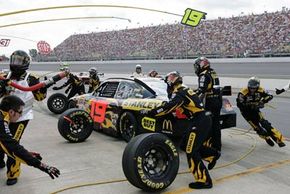Performance on Race Day
All the hard work during testing and practice pays off on race day. Teams can go through as many as 12 sets of tires during a race. Depending on which track the cars are racing on, sticker tires may last a long time or they may fade rather quickly. One thing is certain, a car racing on sticker tires will always be faster than a car with worn tires. Generally, sticker tires are the preferred choice during a pit stop but occasionally teams will put on scuffs or scuffed tires. Scuffed tires are tires that drivers have used for only one or two laps. Scuffs have an advantage in some cases, especially when a driver needs instant grip like during a late race restart. As tire technology advances and Goodyear continues to improve Racing Eagles, scuffs are used less frequently. In rare instances when Goodyear brings an excessively hard tire, as was the case at Atlanta Motor Speedway in the spring of 2008, teams use scuffs to get more grip at the front end of a fuel run or stint.
In tire talk, a stint is the amount of time a tire will be used. Racing tires are designed to be used for a short period of time. Goodyear develops Racing Eagles to last for an approximate distance and depending on the length of the track, stock cars and trucks NASCAR's three major series can run anywhere between 35 and 100 laps on a set of tires. These distances are what the NASCAR teams refer to as fuel runs.
Advertisement
Teams will change tires throughout the race, often choosing to replace tires every time they fuel the car during a pit stop. After the tire is removed from the car, the tire specialist uses a torch to heat up the built-up rubber on the tire so he can remove it and expose three small holes on the tire called wear pins. The tire specialist measures the depth of these pin holes to get indication of how much the tire is wearing, what rate the tire wears and the specific area the tire wears. Crew chiefs use this information to determine what adjustments they need to make during pit stops in order to make the car handle better. Crew chiefs will take all the data as well as input from the driver and tune the car throughout the race. Tires are one of the quickest and most effective areas to tune the car. Tire pressure can greatly affect the handling of the car. A harder tire or a tire with a high amount of air pressure will typically have less grip on the track surface, while the opposite is true for a tire with less air pressure. Sometimes a slight adjustment in tire pressure can give a driver the feel needed to drive straight to the front of the pack.
Tires fail no matter what brand they are. Most of the tire failures in NASCAR are due to punctures from debris on the track or sidewall cuts made during contact between two race cars. When a tire fails at high-speed, not matter what brand it is, the tire will often explode and cause significant damage to the car. Goodyear uses tires with inner liners at high-speed tracks and high-banked intermediate speedways such as Lowe's and Texas Motor Speedways and also at super speedways like Daytona. The inner liner allows the driver to safely control their car in the event of a high-speed failure. The outer tire may shred apart and destroy the sheet metal around the fender, but drivers have much more control on an inner liner than a chewed-up steel rim.
The fastest car doesn't always win. Read the next section to learn why tires fail and how drivers can make all the difference during a NASCAR race. The finish line is just ahead.
